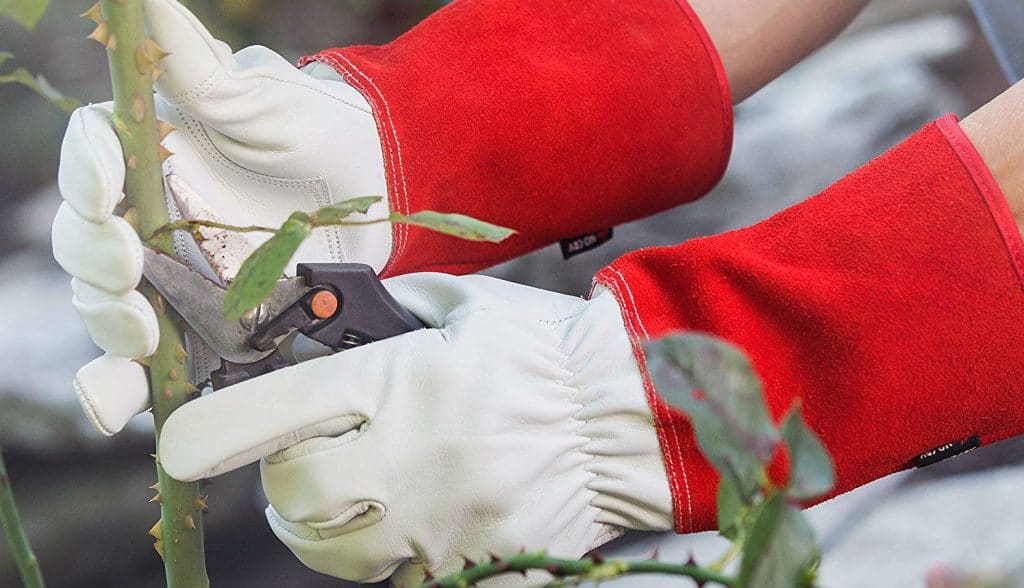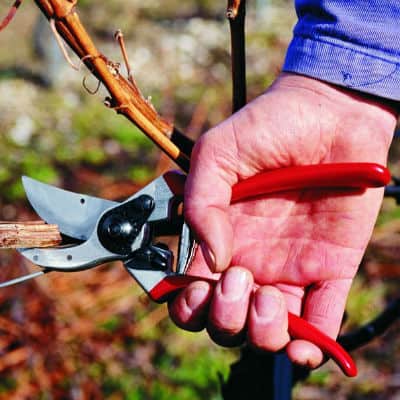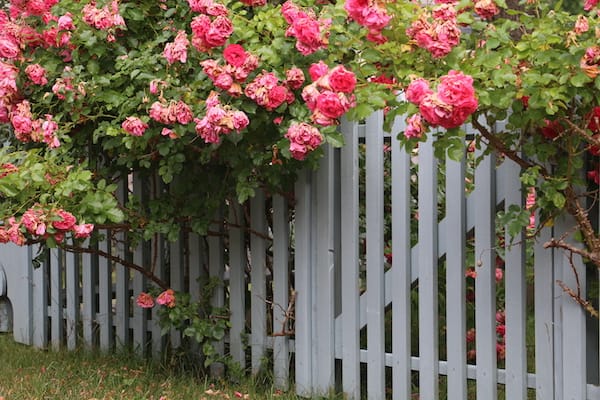Last updated on February 22nd, 2022
Our site is reader supported, this means we may earn a small commission from Amazon and other affiliates when you buy through links on our site.
Knowing how to prune roses is important for anyone who plans to integrate roses into their garden landscape, not just because it helps keep the rose bushes in line, but because it can encourage more beautiful results. You shouldn’t be intimidated by the prospect of pruning. There are very specific rules that are typically applied to specific types of roses that are designed to get the best out of each variety. Casual gardeners who simply need to know how and when to prune roses to keep their bushes healthy and beautiful just need to follow some fundamental guidelines.
If you want to learn how to prune climbing roses click here and to learn how to prune rambling roses click here
What you need for pruning roses

The first thing you need is some good thornproof gloves. It is recommended that you pick the thickest, Gauntlet style you can get, the type of gloves that will protect your entire forearm and not just your hand and wrist. The last thing you want is to regularly stab yourself during the process and because this is something you will do habitually, the investment is well worth it.

You will also need bypass blades. These are special blades that overlap one another so they make a very clean cut. If you choose Anvil blades that meet in the middle they will crush the rose canes and can damage them, so we strongly recommend avoiding this type.
When do you prune roses?
Do all major pruning in spring
Pruning roses in Spring is best, the perfect time being the early spring, right as your roses break their dormancy. Most of your heavy pruning needs to be done in the early spring but wait until the last hard frost has passed and this is usually February to March. And then follow the steps included later in the article.
Deadhead and remove diseases stems and foliage in summer
You can deadhead during the summer, cutting back dead flowers. By deadheading during the flowering season, you can encourage additional blossoms and keep your rose looking very attractive. It’s also a good idea to remove any diseased stems or foliage in summer as soon as you notice them and spray with a rose fungicide.
Cut back tall stems in autumn
You can cut back the longer stems in the autumn to prevent them from snapping during the worst of the winter weather. It is important that you keep your rose bushes protected against strong winds during the winter. If you notice any branches that will be rubbing together they should also be trimmed back. But don’t prune too much because this will stimulate new growth and that new growth will get damaged by the winter weather. The goal is to simply cut away what is absolutely necessary to protect the overall bush. If at any time you see diseased or dead branches or foliage, cut them off, discard them and sterilise the cutting tools that you use to prevent the disease from transferring to your other roses.
How to prune roses
Pruning your hybrid tea, floribunda, old English and patio roses requires very few steps, pruning climbing and rambling roses are done a little differently so we will talk about that further down:
- First, get rid of any remaining leaves that you see. This will help you to get rid of any diseased pieces that might still be hanging on or lying around.
- Secondly, cut off the dead wood first. You know that the wood is dead because it’s brown and usually has no growth on at all. Wood that is living is generally green, however, it can sometimes look brown so be careful not to mistake it for living stems. Anything that is dead should be cut all the way back to the base.
- Take out any branches that are crossing and rub against one another. If you allow them to remain in place it will damage them and encourage diseases, which you obviously want to avoid, prevention is better than cure.
- Get rid of anything that is thinner than the size of a pencil. This type of growth is very weak and won’t render any positive results so you are better off getting rid of it now.
- Prune your remaining canes to your desired height, generally, this depends on how tall you want your roses to grow every year. If you’re not sure we recommend cutting back to 40-50cm by cutting approximately 0.6-1.2cm above any small bumps, also known as outward facing eye buds. These are found where the leaf would otherwise meet the stem. New stems will grow in the direction of your buds so you want to encourage them to grow in an outward fashion rather than an inward fashion. When you are making your cuts do so at a 45-degree angle that slopes away from the bud so that water can run off naturally and does not settle on the buds.
- This step is optional, protect any freshly-made cuts by adding a sealing compound.
- Clean up any of the remaining branches and leaves you cut away and dispose of them. If you leave them sitting near your rose bush they could contain pests or diseases that will find their way into your recently pruned plant.
- Finally, complete the process by adding some long-lasting fertiliser. Remember that rose bushes are very hungry plants so they require a lot of nutrition so will benefit greatly from extra rose feed.
If this sounds far too daunting for you and you simply don’t want to undergo the process of regularly pruning, you could just prune back to 40-50cm every March and remove any dead or diseased stems once a year.
Frequently asked questions about pruning
What height should the plant be?
The height to which you prune your rose bush should be whatever height you prefer but make sure that you keep it consistent. Most roses will give an eventual height of 3 to 4ft but in reality, if left unpruned they could easily grow to 6-8ft. So if you want to keep your roses at 3-4ft then we would recommend cutting back to around 2ft. If you think they got a little too tall, just prune them back a little harder next time. Roses can, if needed, be cut back very hard.
What if I have climbing roses?

The same rules apply to climbing roses but the difference is that climbing roses typically have two different types of canes. The main cane makes the main framework for the rose and the lateral side canes generally get all of the flowers. The main canes that make the framework should never be pruned, with the exception of keeping them within a certain size of framework, such as making sure it grows no taller than 10ft for example.
Trim the side shoots to keep them within the framework but these can be cut every year and to a good set of buds.
Rambling roses

You can usually tell if you have rambling roses and not a climber because they usually flower later and just once, whereas climbing roses flower all summer long. Prune back rambling roses after they have finished flowering and produced rose hips.


